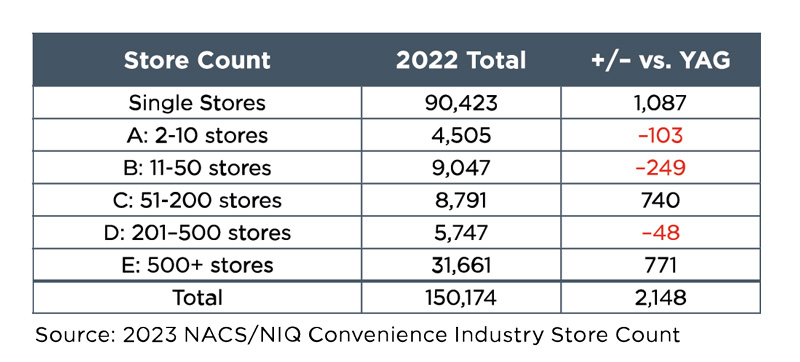The c-store universe is growing again: The NACS/NIQ Convenience Store Census reported that there were 150,174 convenience stores as of December 31, 2022, up from 148,026 at year end 2021. That growth comes after four straight years of declines.
Throughout 2022, most M&A activity consisted of smaller deals, which is reflected in the store count declines among A and B size operators. After several years of shrinking numbers amid industry consolidation and a tough business climate, the number of single stores increased by 1,087 sites in 2022. They now account for 60.2% of all convenience stores.

Most of the store count growth in 2022 came from the C and E size operators. Casey’s, Wawa, Kwik Trip, Sheetz and QuikTrip accounted for 10% of the total site increase.
Consolidation Continues
During the NACS State of the Industry Summit, John Benson of AlixPartners cited fundamental shifts that are happening in the convenience retail industry. “Our industry will look different five years from now and 10 years from now than it does today,” he said.
One of those shifts is industry consolidation, a longer-term trend that will continue to change how retailers compete and differentiate their brands. “More and more of your competitors are going to be larger, well-funded and well-capitalized companies, and they’re going to be making investments to try to win more share of consumers,” said Benson.
Ready for Battle
As the industry continues to grow through consolidation, as well as organic growth, two industry leaders walked SOI Summit participants through their real-life process of assessing growth and risk before deploying capital: John Phelps, president and CEO of Carroll Independent Fuel/High’s of Baltimore, and Spencer Cavalier, co-head of downstream energy and convenience retail at Matrix Capital Markets Group.
High’s was founded in 1928 as an ice cream store. It grew into a chain that at one time had more than 500 locations. Carroll Independent Fuel Co. is a family-owned company that has been in business more than 117 years. Along the way, Carroll has made many capital allocation decisions, including getting back into directly operating convenience stores by purchasing High’s in March 2012.
Based in the Delmarva region (Delaware, Maryland, Virginia), High’s today has more than 60 convenience stores. Phelps was candid about the journey Carroll took to build the brands it has today, including a “fast fail” when it directly operated On the Run stores. “We lost a lot of money in a very short period of time and quickly retreated,” he said.
Rather than shy away, the company chose to embrace changes in the industry and reenter retail.
“We want to control our destiny. We decided to focus on two primary pillars: High’s being our ‘retail weapon’ that we could go toe-to-toe with against the big guys, and then Carroll is everything else,” he said, which includes roughly 250 dealer sites and the commercial, transportation and construction side of the business.
The battleships: High’s focuses on flawless execution and the retail buying experience. “That’s the battleship vision,” said Phelps. It includes doing a few things really well, like offering great food and super premium ice cream. One example of a battleship location is the High’s store in Gambrills, Maryland, that was featured in the NACS Ideas 2 Go video “Revitalizing the Brand.”
The destroyers: These are stores that do not make the “optimization” cut, a process Phelps describes as determining which sites have the greatest potential. These sites can be dealer-operated Carroll Motor Fuels-branded sites or even High’s-branded sites that are not the right fit for executing a High’s foodservice program because of the location and/or store size.
Cavalier noted that there’s advice often heard throughout the convenience retail industry: You constantly have to invest. But not many companies have two distinct options to invest in.
“A lot of people fall into the trap of, ‘I want to sell all of my B or C sites and invest into these battleships and compete.’ That’s the new age, but not everybody should do that,” he said, adding that convenience is a return-generating business and there still are great returns in smaller-format stores.
Deploying Capital Into Growth
As a family-run company, “The business always eats first. We always eat last,” said Phelps. In terms of where to deploy capital, most companies are likely looking at the same area: building an electric vehicle charging infrastructure. “It’s probably 15 or 20 years out, but it’s going to happen,” he said.
The suggestion is this: “Rather than fear it, let’s embrace it and let’s do other things, but let’s also be totally efficient with what capital we do spend in the meantime.”
Cavalier noted another area retailers often struggle with, and that’s whether to turn a destroyer site into a battleship site.
“We constantly measure every capital deployment that we’ve made,” said Phelps. “Whether it’s a bean-to-cup machine or a chicken fryer, we’re always looking at what those returns are.”
“Also, if we’re going to fail—and we do—we need to fail quickly and make sure we don’t make that mistake again. It’s all about measuring and learning,” he said.